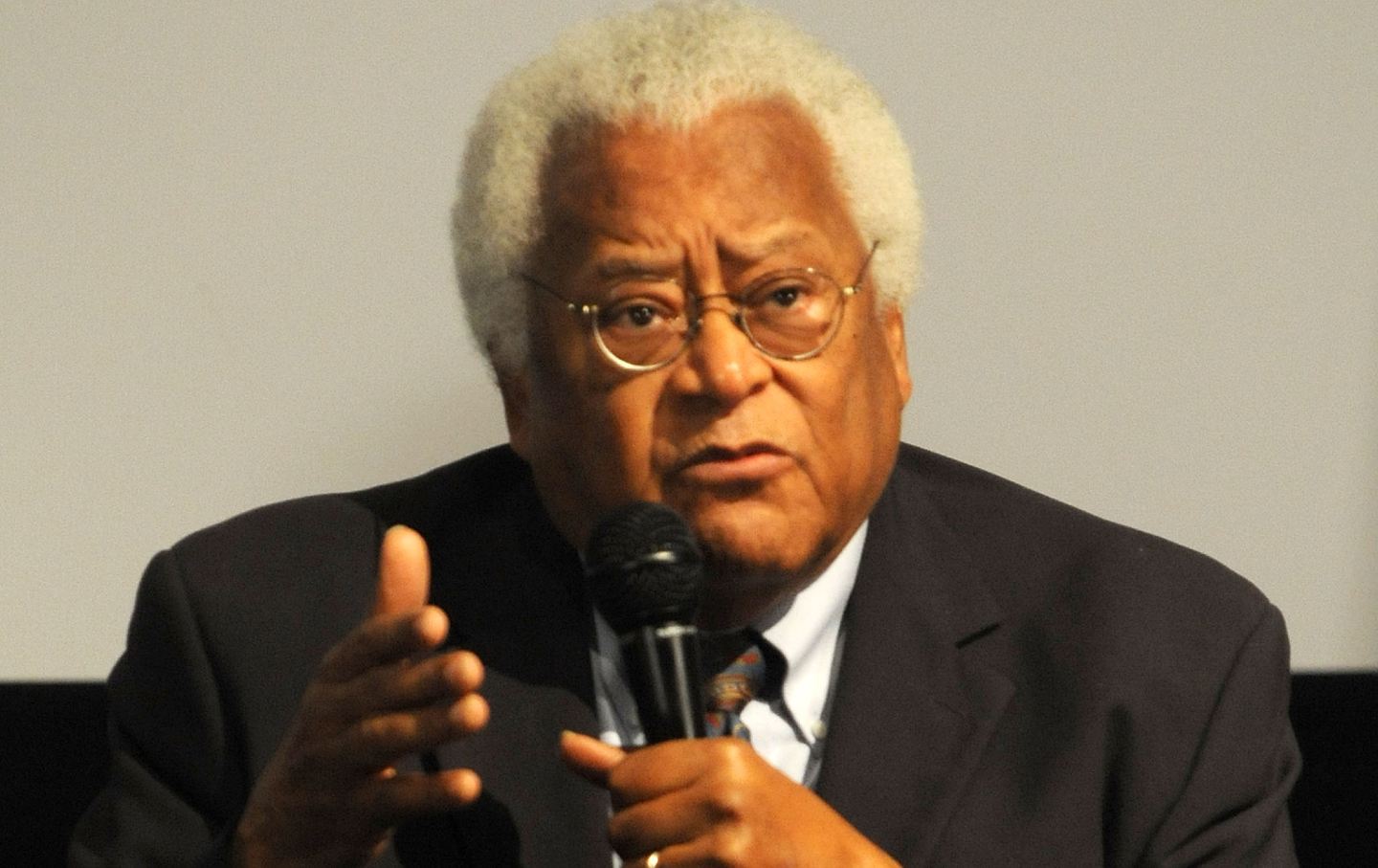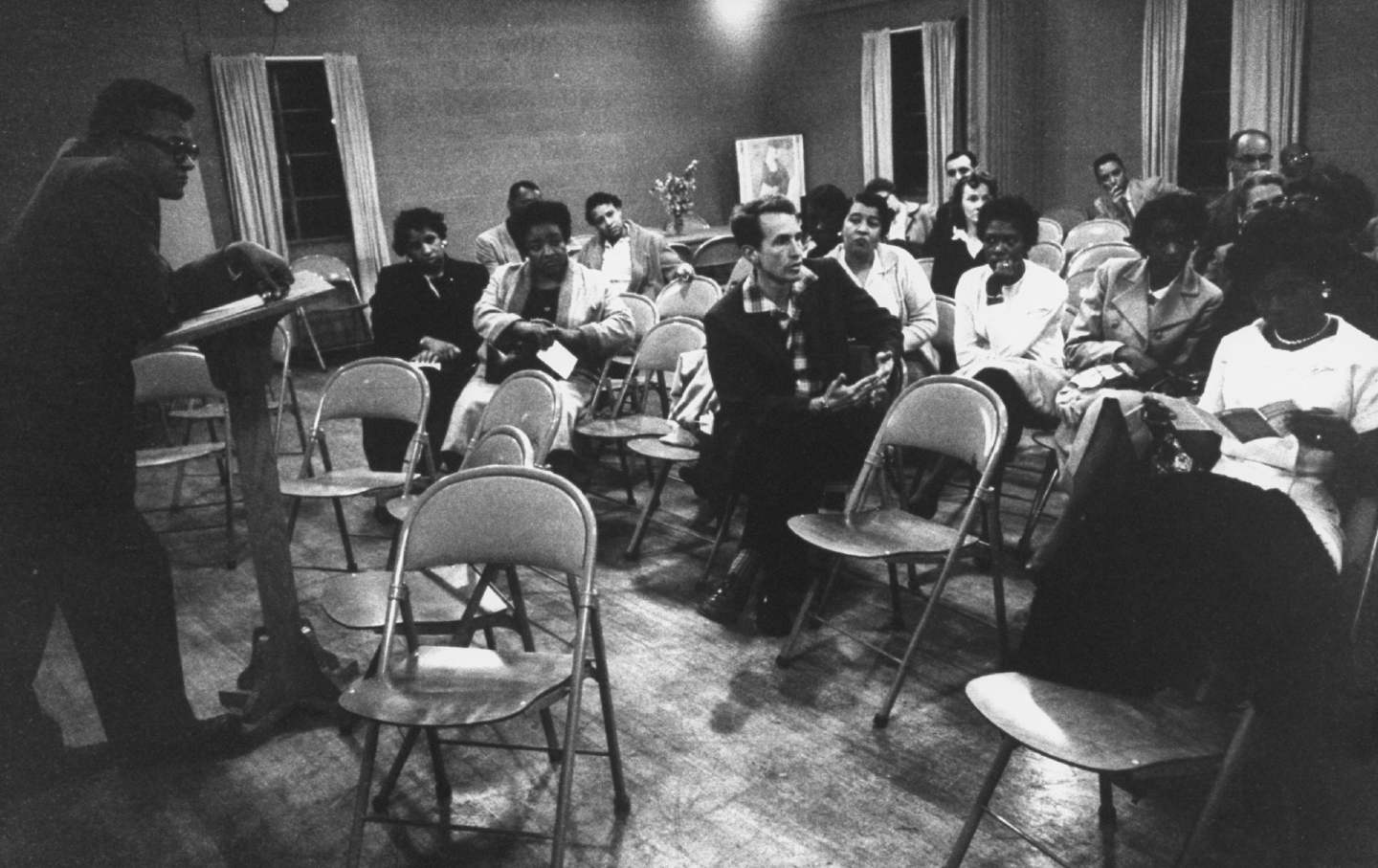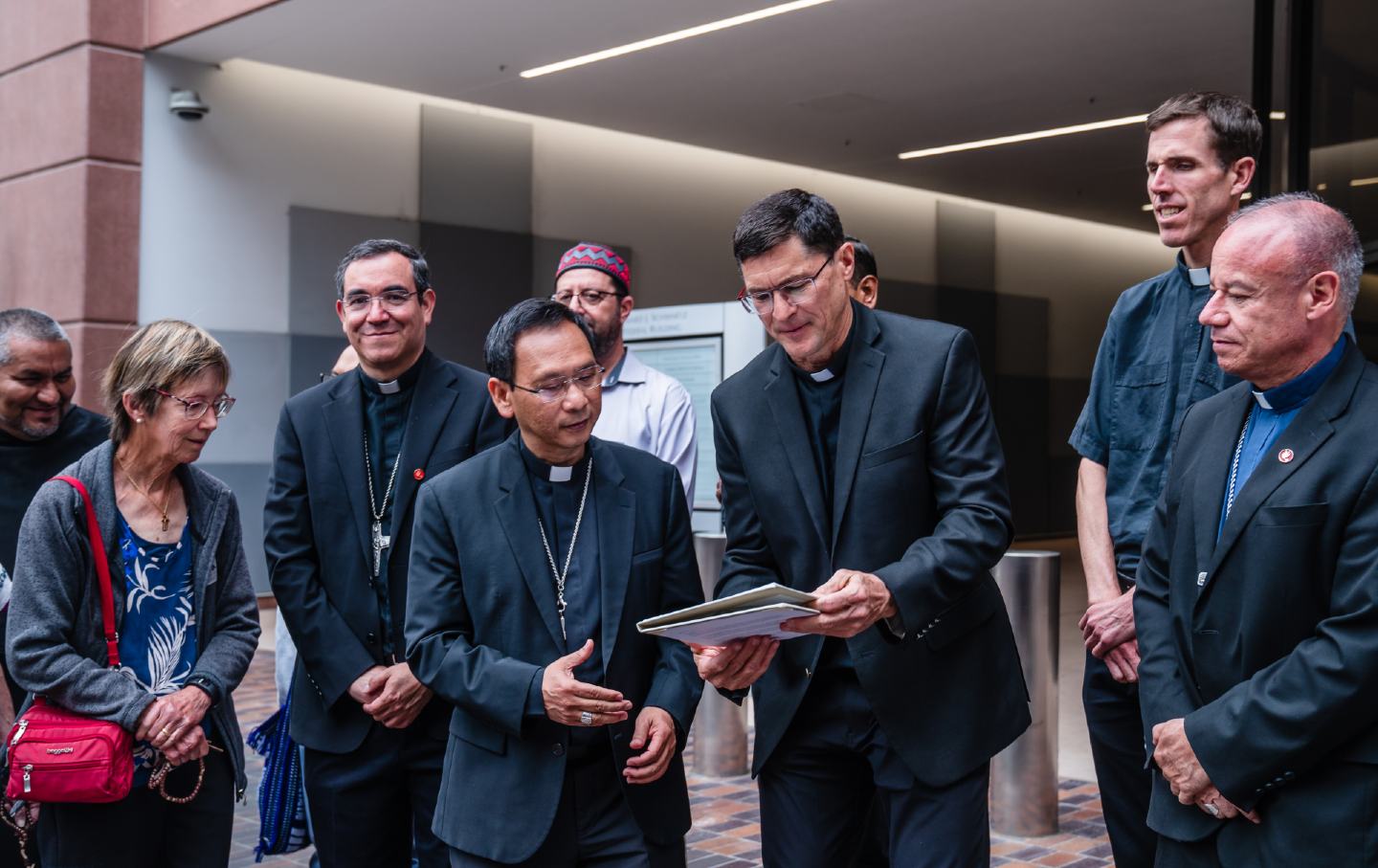
The Rev. James M. Lawson Jr., whom Martin Luther King called “the greatest teacher of nonviolence in America,” died on June 9 in Los Angeles at 95.
Although not well-known to the wider public, Lawson had a significant influence on generations of civil rights, labor, and peace activists.
Lawson was raised in Massillon, Ohio. His father was a strong-willed Methodist preacher, who packed a pistol in his belt and taught his son, the sixth of nine children, to fight for himself even if the odds were against him. Lawson’s mother, an immigrant from Jamaica, took a different approach. As a fourth grader, he proudly told his mother that he slapped a white boy across the face after he called him a “nigger.” She admonished him, urging him always to be guided by love. The moment, he later reflected, was a “sanctification,” an epiphany that there was a better way to live.
At Baldwin-Wallace College, Lawson met A. J. Muste when the pacifist leader of the Fellowship of Reconciliation (FOR) spoke on campus, and he immediately joined FOR’s local chapter.
In the spring of his senior year, Lawson received a draft notice. He had decided to pursue the ministry and could have received a deferment, but he thought it was unconscionable for clergy to be deferred while others had to serve in the Korean War. He ended up serving 13 months in prison.
After his release, Lawson moved to Nagpur, India, where he worked for three years as a Methodist missionary and studied satyagraha—Mohandas Gandhi’s principles of nonviolent resistance.
One day in 1955, while in India, Lawson was reading a newspaper and saw photographs of masses of African Americans launching a bus boycott in Montgomery, Alabama. He began whooping, clapping, and dancing in joy. This shocked a colleague in the next hut, who only knew Lawson as a serious and cerebral man. But for Lawson, the photographs offered evidence that a nonviolent mass movement was taking hold back home.
He returned to the United States and began working on his master’s degree in theology at Oberlin College. But in 1957, Martin Luther King came to Oberlin to speak, and the two men made an instant connection. King urged Lawson to come immediately to the South. In 1958, Muste appointed Lawson the FOR’s Southern field secretary, allowing him to move to Nashville and travel throughout the South conducting workshops in nonviolence for small groups of Black teenagers, college students, and adults, many of them cosponsored with King’s Southern Christian Leadership Conference.
In 1959 Lawson enrolled as a divinity student at Vanderbilt University and began holding workshops in a church basement for students from Vanderbilt and four local Black colleges: Fisk University, American Baptist College, Meharry Medical College, and Tennessee Agricultural and Industrial State University.
Lawson believed that only a nonviolent movement, led by young people, would end segregation. It would require physical courage, unshakable conviction—and a willingness to forgive those who would beat them.
Lawson was a master strategist and careful planner. In his workshops, small groups of students, Black and white, engaged in role-playing exercises. Some played angry white racists pounding on protesters while calling them racist epithets. Lawson taught them to withstand the taunts, slurs, and blows of the segregationists and to protect themselves without retaliating.
Many of Lawson’s protégés—including John Lewis, Diane Nash, Bernard Lafayette, and James Bevel—became movement leaders.
In February 1960, inspired by the initial sit-in in Greensboro, North Carolina, a few days earlier, students crammed into Nashville’s First Baptist Church, eager to join the crusade. They wanted to stage a local sit-in the next day. Worried that without training, their action would be a disaster, Lawson led a crash course in nonviolence that lasted well into the night.
The next morning, about 500 activists went to Nashville’s downtown stores, requesting to be served. They dressed impeccably and carried books to read. One group of students sat at a counter, were knocked down, beaten, and arrested. Then another group took their place, and the pattern was repeated.
More than 150 students were arrested. A lead editorial in the Nashville Banner, one of the city’s two daily newspapers, quoted Lawson as urging students to “violate the law,” which the paper called “incitation to anarchy.”
Lawson helped organize Nashville’s Black community, outraged by the arrests and the brutal treatment of the student protesters, to boycott downtown stores. Many whites also stayed away, some out of sympathy, others out of fear. Business leaders pressured the mayor and city council to resolve the controversy. The next month, Nashville’s lunch counters began to serve African Americans.
In April 1960, Lawson delivered the keynote speech at the Student Nonviolent Coordinating Committee’s founding meeting in North Carolina. The sit-ins, Lawson told the assembled activists, represented a “judgment upon middle-class conventional halfway efforts to deal with radical social evil.”
Popular
“swipe left below to view more authors”Swipe →Amid the growing sit-ins, and under pressure from Vanderbilt’s board members, the dean of the Divinity School asked Lawson to withdraw. Lawson refused, and the board expelled him. But the university got more than it bargained for. Lawson’s expulsion, reported on the front page of The New York Times, motivated 10 Divinity School professors, including the dean, to resign in protest, forcing the school to eventually offer Lawson a reinstatement. He opted instead to complete his degree at Boston University.
In 1961, after the first wave of Freedom Riders were met with mob violence, including the fire-bombing of a bus in Alabama, some activists thought the project should be halted. The Nashville students called Lawson, who endorsed the students’ plan to send a new wave of Freedom Riders to Alabama to continue the campaign. Lawson told the students he would join them.

On May 24, graduates from Lawson’s workshops joined other activists aboard a Trailways bus from Montgomery, Alabama, to Jackson, Mississippi. Despite warnings of bomb threats along the way, the riders arrived safely in Jackson and, upon exiting the bus, filed into the “whites only” waiting room. They were promptly arrested.
Two days later, Lawson and the other arrested riders appeared in court. The judge, an extreme segregationist, found all 27 defendants guilty, sentencing each to pay a $200 fine. He wanted them out of Mississippi and the national media spotlight. But many of them refused to pay their fines and instead served sentences in Mississippi’s notorious Parchman Prison, where some were beaten by the guards. In the meantime, hundreds of other Freedom Riders had joined the crusade, drawing worldwide attention that heightened the unease within the Kennedy administration.
In June, a delegation of Freedom Riders and their supporters, including Lawson, met with Attorney General Robert Kennedy at the Justice Department in Washington, DC. After that meeting, Kennedy pressured the federal Interstate Commerce Commission to issue new policies desegregating bus travel. That September, the commission announced new rules whereby passengers would be permitted to sit wherever they pleased on interstate buses and trains, “white” and “colored” signs would come down in the terminals, and bus station lunch counters would have to serve people regardless of race.
On February 12, 1968 in Memphis, 1,300 Black sanitation workers—who toiled in dangerous conditions for pitiful wages and no benefits—went on strike after two workers were killed when a truck malfunctioned. They demanded a pay raise, overtime pay, merit promotions without regard to race, and city recognition of AFSCME as their union bargaining agent. For the next several months, city officials refused to negotiate.
Lawson, by then pastor of Memphis’s Centenary United Methodist Church, mobilized community support for the striking workers, including protest rallies, demonstrations, and a sit-in at City Hall.
The Memphis police attacked the union members, ministers, and others indiscriminately, often using clubs and mace. While Lawson counseled nonviolence, the police were clearly trying to provoke the protesters, even arresting some of them for jaywalking.
Lawson persuaded King to come to Memphis to boost morale among the strikers and to generate national attention for the walkout. King’s last speech was given at the Mason Temple, the day before he was murdered as he stood on the balcony of his room at the Lorraine Motel.
After President Lyndon B. Johnson ordered federal troops to Memphis, the Memphis City Council passed a resolution recognizing the union. The strikers won a 14-month contract that included union dues check-off, a grievance procedure, and wage increases.
In 1974, Lawson left the South to become pastor at the 2,700-member Holman Methodist Church in Los Angeles. There he became involved with the labor movement, the American Civil Liberties Union, and movements for reproductive choice, immigrant rights, and LGBTQ rights. He served as chairman of LA’s Clergy and Laity United for Economic Justice, as national chair of the Fellowship of Reconciliation, and as host of Lawson Live, a weekly cable television and call-in radio show, where he discussed social justice issues.
Soon after arriving in LA, he started offering monthly workshops on nonviolence for members of his congregation and others engaged in social justice work. Lawson retired from Holman in 1999, but continued to teach the Saturday morning workshops until a few months ago, inspiring a new generation of organizers and progressive politicians..
Maria Elena Durazo, who had led a rebellion against the old guard at the hotel workers union and was elected president of UNITE HERE Local 11, was one of many activists whoattended Lawson’s workshops.
“We needed his guidance and he was always there for us,” said Durazo, who later became the first woman head of the LA County Federation of Labor and is now a California state senator. She invited Lawson to meet with Local 11’s mostly immigrant Latina hotel and food workers. He helped them win higher wages and improved working conditions by orchestrating nonviolent sit-ins, hunger strikes and civil disobedience protests.
“His contribution wasn’t just to the labor movement but to the wider progressive movement,” Durazo said.
As a young labor lawyer, Kent Wong also attended Lawson’s workshops. After he became director of UCLA’s Labor Center, he co-taught a course with Lawson on nonviolence for 22 years that, Wong said, “has helped recruit and train students and young people to advance our movement for social change.”
Ju Hong met Lawson in 2011 as a young immigrant rights activist. “I remember his teachings on the power of organizing, advocacy, and nonviolent direct actions,” said Hong, who is now director of UCLA’s Dream Resource Center, which trains immigrant rights organizers. “Those are lessons you never forget.”
In 1989, Lawson was one of three dozen people arrested at the Federal Building in downtown Los Angeles while protesting US support for the government of El Salvador. In 1997, he led protest rallies to push the Los Angeles City Council to approve a “living wage” ordinance to raise wages for low-wage workers. The next year, he marched onto the University of Southern California campus in support of unionized food service and facilities workers. When LA’s garbage workers were organizing a union drive, Lawson connected them with several of the Memphis sanitation workers from the 1968 strike.
He took part in a 2003 Immigrant Workers Freedom Ride to mobilize public support to immigration reform and challenge the widespread immigrant-bashing that occurred in the wake of 9/11.
“No human being in the sight of God is illegal,” Lawson declared at one rally. “The fight for the civil rights of workers who come here from all over the world is the same as the Freedom Rides of 1961 and the continuing struggle for civil and human rights for all.”
In 2005, Vanderbilt University bestowed Lawson with its Distinguished Alumnus award, then invited him to teach as a distinguished visiting professor for three years, and named an endowed professorship and an institute for nonviolence in his honor.
“No other alumnus has ever contributed so much to issues of national and international justice and peace, and the promotion of a nonviolent world view,” said Chancellor Gordon Gee, 45 years after the university had expelled Lawson for leading civil rights protests. In 2021, Durazo and Wong led the successful effort to name UCLA’s downtown labor center the James Lawson Jr. Worker Justice Center.
Disobey authoritarians, support The Nation
Over the past year you’ve read Nation writers like Elie Mystal, Kaveh Akbar, John Nichols, Joan Walsh, Bryce Covert, Dave Zirin, Jeet Heer, Michael T. Klare, Katha Pollitt, Amy Littlefield, Gregg Gonsalves, and Sasha Abramsky take on the Trump family’s corruption, set the record straight about Robert F. Kennedy Jr.’s catastrophic Make America Healthy Again movement, survey the fallout and human cost of the DOGE wrecking ball, anticipate the Supreme Court’s dangerous antidemocratic rulings, and amplify successful tactics of resistance on the streets and in Congress.
We publish these stories because when members of our communities are being abducted, household debt is climbing, and AI data centers are causing water and electricity shortages, we have a duty as journalists to do all we can to inform the public.
In 2026, our aim is to do more than ever before—but we need your support to make that happen.
Through December 31, a generous donor will match all donations up to $75,000. That means that your contribution will be doubled, dollar for dollar. If we hit the full match, we’ll be starting 2026 with $150,000 to invest in the stories that impact real people’s lives—the kinds of stories that billionaire-owned, corporate-backed outlets aren’t covering.
With your support, our team will publish major stories that the president and his allies won’t want you to read. We’ll cover the emerging military-tech industrial complex and matters of war, peace, and surveillance, as well as the affordability crisis, hunger, housing, healthcare, the environment, attacks on reproductive rights, and much more. At the same time, we’ll imagine alternatives to Trumpian rule and uplift efforts to create a better world, here and now.
While your gift has twice the impact, I’m asking you to support The Nation with a donation today. You’ll empower the journalists, editors, and fact-checkers best equipped to hold this authoritarian administration to account.
I hope you won’t miss this moment—donate to The Nation today.
Onward,
Katrina vanden Heuvel
Editor and publisher, The Nation
More from The Nation

San Diego’s Clergy Offer Solace to Immigrants—and a Shield Against ICE San Diego’s Clergy Offer Solace to Immigrants—and a Shield Against ICE
In no other US city has the faith community mobilized at such a large scale to defend immigrants against the federal government.

If Condé Nast Can Illegally Fire Me, No Union Worker Is Safe If Condé Nast Can Illegally Fire Me, No Union Worker Is Safe
The Trump administration is making employers think they can ignore their legal obligations and trample on the rights of workers.

The Counteroffensive Against Operation Midway Blitz The Counteroffensive Against Operation Midway Blitz
How Chicago residents and protesters banded together against the Trump administration's immigration shock troops.

In an Unusual Twist, the Prosecution of a Gaza Protester Puts Israel on Trial In an Unusual Twist, the Prosecution of a Gaza Protester Puts Israel on Trial
An activist argued that genocide in Gaza necessitated disrupting business as usual. The City of Chicago argued in defense of Israel—and against civil disobedience.

The Left Must Build Its Infrastructure The Left Must Build Its Infrastructure
We need to look not at what it will take to win the next election, but what it’ll take to win the next 10 elections.

Public Health Was a Place for Warriors Once. It Needs to Be Again. Public Health Was a Place for Warriors Once. It Needs to Be Again.
It's time for us to reconnect with the radical, system-changing spirit that was once at the heart of our field.


